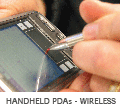Compact Flash
Introduction

Compact flash cards are small, pluggable devices which can provide additional functionality to a device. Originally designed as a storage medium ('flash' as in NAND flash), compact flash cards can now be used to provide functionality such as: Ethernet, Wi-Fi, GPS and Bluetooth. Compact flash cards come in two thicknesses: Type one cards, which are 3.3mm thick, and type two cards which are 5mm thick. Compact flash cards have a pin compatible subset of the earlier PC Card (formerly known as PCMCIA), but are generally much smaller. Adapters are widely available to allow compact flash cards to be connected to PC card slots.
The CompactFlash Association has a website which links to various information on the standards. There is also a useful FAQ on the subject.
While Compact Flash is these days physically much larger than alternative memory cards, it has found its niche in high-end digital camera and PCs where solid state storage is required in large amounts and space is not at such a premium.
Compact Flash on the Rig 200
The Rig 200 has a standard compact flash socket which can be used to add additional functionality to the board. There is also a second socket on the compact flash bus, which is optionally connected to the Wi-Fi Plus Option module. Snapper 255 is able to utilise both the compact flash socket and the Wi-Fi Plus Option module simultaneously, however Snapper CL15 can only be configured to access one of the devices at a time.
In order to use compact flash on the Rig 200 you will need:
- Rig 200 baseboard.
- Any compact flash card (Both type one and two are supported).




